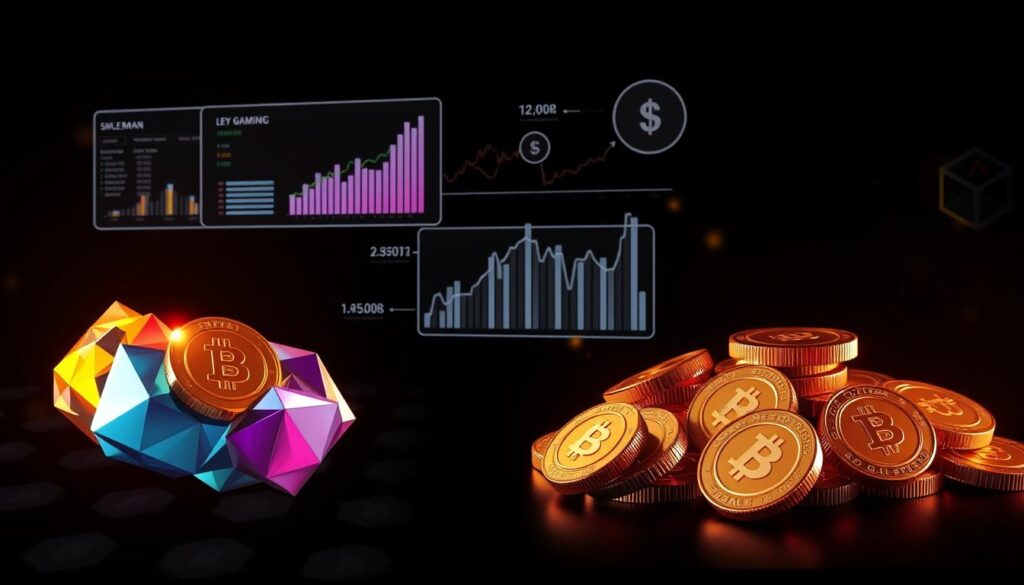Now Reading: Yield Farming 101: Earn Passive Income with Crypto
- 01
Yield Farming 101: Earn Passive Income with Crypto
Yield Farming 101: Earn Passive Income with Crypto

Imagine earning cryptocurrency rewards simply by staking digital assets you already own. This strategy, powered by decentralized finance (DeFi), has reshaped how investors approach passive income. By providing liquidity to blockchain networks, participants can unlock returns far beyond traditional savings accounts.

The DeFi sector exploded in 2020, growing from $500 million to $10 billion in market value. At its core lies a practice where users lend or lock crypto tokens into smart contracts. These automated agreements distribute rewards based on participation levels and platform rules.
While the potential rewards attract many, this approach carries significant volatility. Market fluctuations and protocol changes can impact earnings dramatically. However, when managed carefully, it creates opportunities for consistent returns through various blockchain applications.
This guide will walk you through essential concepts, risk management techniques, and strategies to maximize rewards. You’ll learn how liquidity mining works, compare platforms, and discover tools to navigate this dynamic space safely.
Key Takeaways
- DeFi-powered strategy for generating crypto rewards through asset participation
- Market value surged 20x in 2020 due to innovative protocols
- Relies on liquidity provision to decentralized exchanges and lending platforms
- Higher potential returns come with increased market volatility
- Requires understanding of smart contracts and risk assessment
Getting Started with Yield Farming Basics
Crypto enthusiasts can generate returns by participating in automated protocols. Unlike traditional investing, this method requires active engagement with decentralized platforms. You’ll need compatible digital assets and a crypto wallet to begin.
Most protocols require you to deposit tokens into liquidity pools – shared reserves that power trading on decentralized exchanges. These pools use smart contracts to automatically distribute rewards based on your contribution size. Returns typically appear as APY percentages, which fluctuate as more users join the pool.

- Choose a DeFi platform supporting your preferred assets
- Deposit tokens into a compatible liquidity pool
- Earn fees from trades or governance tokens as rewards
Early participants often see higher APYs because fewer users split the rewards. However, minimum deposits vary – some platforms start at $100, while others require larger commitments. Stablecoins like USDC and DAI are popular choices due to their price stability.
Always verify smart contract security before depositing funds. This foundational knowledge helps navigate DeFi platforms effectively while managing risk exposure.
Understanding Yield farming Concepts
Decentralized finance introduced a novel way to earn through protocol participation. This system lets users grow their crypto holdings by supporting blockchain networks – not just through holding assets, but by actively fueling DeFi ecosystems.

What Exactly Is Yield Farming?
Often called liquidity mining, this process rewards users who lock tokens into smart contracts. Platforms like Compound pioneered this model in 2020 by distributing COMP tokens to participants. These incentives encourage users to supply assets that power lending, trading, and other DeFi services.
While the terms are sometimes used interchangeably, there’s a slight difference. Yield farming broadly refers to earning through multiple DeFi strategies, whereas liquidity mining specifically involves receiving platform tokens as extra compensation.
How Liquidity Pools Function
These shared reservoirs enable decentralized exchanges to operate smoothly. When you deposit tokens into a pool, you become a liquidity provider – essentially a market maker. Automated systems maintain balanced ratios (like 50% ETH/50% USDC) to facilitate instant trades.
Key benefits for participants include:
- Earning transaction fees from swaps
- Receiving governance tokens as bonuses
- Contributing to protocol growth
Rewards scale with your stake in the pool. Larger deposits mean bigger slices of the fee/reward pie. However, all participants share risks equally – including potential value shifts between paired assets.
The Mechanics Behind Liquidity Mining and DeFi Protocols
Blockchain technology has automated financial services through self-executing agreements that power modern DeFi protocols. These systems eliminate banks and brokers while ensuring transparent reward distribution. At their core, two innovations drive liquidity mining: programmable smart contracts and decentralized trading mechanisms.
Smart Contracts and Automated Market Makers
Smart contracts handle complex calculations instantly. They determine rewards based on deposited amounts and pool activity. Automated market makers (AMMs) maintain asset ratios in liquidity pools, enabling 24/7 trading without order books.
Key features of AMM systems include:
- Instant price adjustments through mathematical formulas
- Fee collection from every trade (0.1%-0.3% typically)
- Real-time reward distribution to participants
The Role of Governance Tokens in the Ecosystem
Most DeFi protocols reward users with governance tokens. These assets let holders vote on platform upgrades while serving as tradable rewards. Popular tokens like UNI and COMP trade on both Coinbase and decentralized exchanges.
Strategic participants diversify across multiple platforms to:
- Balance risk across different protocols
- Capture higher APYs from emerging platforms
- Benefit from varied incentive structures
Token value depends on protocol adoption and voting utility. This dual-purpose model creates competitive ecosystems where users directly influence platform evolution.
Navigating DeFi Ecosystem Risks and Rewards
The decentralized finance landscape offers lucrative opportunities but demands careful navigation of its inherent risks. Participants must balance potential rewards with threats like sudden market shifts and protocol failures. Understanding these challenges separates informed investors from those vulnerable to costly mistakes.

Identifying Risks: Impermanent Loss and Rug Pulls
Impermanent loss occurs when pooled assets change value relative to each other. For example, if ETH doubles against USDC while in a liquidity pool, providers might face losses when withdrawing compared to holding both tokens separately. This temporary discrepancy becomes permanent upon exiting the pool.
Malicious schemes called rug pulls plague the DeFi ecosystem. Developers create flashy projects with unrealistic returns – think “DogeFarm” offering 5,000% APY – then vanish with locked funds. Warning signs include anonymous teams, unaudited code, and pressure to invest quickly.
- Check audit reports from firms like CertiK
- Avoid pools using meme tokens as primary rewards
- Monitor withdrawal patterns in protocol dashboards
Smart contract vulnerabilities remain critical risks. Even established platforms can suffer exploits, as seen in 2022’s $600M Poly Network breach. Always verify security scores and insurance options before using strategies to farm crypto rewards safely.
Successful yield farmers diversify across protocols and set strict loss thresholds. They treat high APYs as red flags rather than guarantees, remembering that sustainable returns rarely exceed triple digits.
Exploring Popular Yield Farming Protocols and Platforms
Decentralized platforms have transformed how investors earn passive income through protocol participation. With over $200 billion locked in DeFi systems, choosing the right platform requires understanding their unique reward structures and risk profiles.
Insights into Leading DeFi Platforms
Aave dominates lending markets with $21 billion in assets, offering up to 15% APR for stablecoin providers. Compound’s money market protocol delivers 0.21%-3% APY through its algorithmic rate adjustments. For stablecoin specialists, Curve Finance combines 10% base returns with 40%+ bonus rewards through its CRV token.
Uniswap’s V2 and V3 pools handle $7 billion combined, while PancakeSwap on Binance Smart Chain attracts users with 400%+ APYs on select pairs. These platforms demonstrate how yield farming basics adapt across different blockchain ecosystems.
Comparing Annual Percentage Yields Across Protocols
APY variations reflect distinct protocol strategies:
- Established platforms (3-15%): Lower risk, verified track records
- Cross-chain services (40-80%): Higher rewards with multi-network exposure
- Aggregators like Yearn.finance: Auto-optimized returns up to 80% APY
While Venus Protocol offers 8-12% on BSC, newer platforms often provide temporary boosts to attract liquidity. Users should analyze lock-up periods and token distribution models when evaluating advertised rates.
Strategies for Maximizing Passive Income in Crypto
Advanced crypto strategies now leverage automation to boost earnings while managing risks. Savvy participants spread their assets across protocols, balancing high returns with diversified exposure. This approach reduces reliance on single platforms and capitalizes on shifting market conditions.
Automated Yield Aggregators and Optimized Returns
Smart contract “vaults” handle complex moves across DeFi platforms automatically. These systems scan for the best liquidity opportunities, moving funds between lending pools and trading venues. Users earn compounded rewards without daily monitoring.
Key advantages of automation include:
- 24/7 strategy adjustments based on real-time data
- Access to delta-neutral positions that minimize volatility
- Lower gas fees through batch transactions
Platforms like Yearn Finance demonstrate how aggregated assets can capture arbitrage gaps. However, automated tools charge performance fees (often 20% of profits). Always review contract permissions and withdrawal terms before committing funds.
While these systems simplify participation, understanding their mechanics remains crucial. Manual strategies still work for niche opportunities, but automation typically delivers more consistent returns over time.
Real-World Applications and Use Cases of Yield Farming
Decentralized finance reshaped investment strategies through practical implementations that engage communities and distribute influence. The ecosystem thrives when participants actively shape protocols while earning rewards. Two critical developments demonstrate this dynamic: historical incentive models and evolving token distribution frameworks.
Examples from the DeFi Summer and Beyond
June 2020 marked a turning point when Compound introduced governance tokens (COMP) to reward users. This sparked the “DeFi Summer,” where platforms competed to attract liquidity through creative token distributions. Yearn Finance’s YFI launch became legendary – 30,000 tokens distributed without pre-mining, aligning rewards with genuine platform usage.
Token Distribution Models and Community Impact
Fair-launch models revolutionized how protocols build trust. By letting communities earn tokens through participation instead of purchases, projects like Yearn fostered loyal user bases. These decisions create ecosystems where governance power correlates with contribution levels.
Modern platforms now prioritize transparent processes for reward allocation. This shift ensures long-term growth by aligning incentives between developers and users. As decentralized applications mature, their success increasingly depends on equitable community engagement models.
FAQ
What exactly is yield farming?
Yield farming involves lending or staking crypto assets in decentralized finance (DeFi) protocols to generate returns. Participants contribute to liquidity pools and earn rewards, often in governance tokens or transaction fees, based on their share of the pool.
How do liquidity pools function?
Liquidity pools are smart contract-based reserves where users deposit assets to enable trading, lending, or borrowing. Automated market makers (AMMs) like Uniswap use these pools to execute trades, and providers earn fees proportional to their contributions.
What role do governance tokens play in DeFi?
Governance tokens, such as Compound’s COMP or Aave’s AAVE, let holders vote on protocol upgrades and decisions. These tokens incentivize participation, aligning user interests with the platform’s long-term growth.
What is impermanent loss?
Impermanent loss occurs when the value of assets in a liquidity pool diverges from holding them outside the pool. This risk arises from market volatility and can reduce potential returns for liquidity providers.
Which platforms offer competitive annual percentage yields (APY)?
Protocols like Curve Finance, PancakeSwap, and Yearn.Finance often provide high APYs. Rates vary based on demand, asset types, and platform incentives, requiring users to compare options regularly.
How do automated yield aggregators work?
Platforms like Yearn.Finance automatically shift funds between DeFi protocols to optimize returns. They reduce manual effort by leveraging algorithms to identify the highest-yielding opportunities in real time.
What were key milestones during DeFi Summer?
The 2020 “DeFi Summer” saw explosive growth with launches like SushiSwap and Uniswap’s UNI token distribution. These events highlighted decentralized governance and community-driven token models, reshaping crypto ecosystems.
How do rug pulls affect participants?
Rug pulls occur when developers abandon a project, draining locked funds. To avoid scams, research platforms’ audit histories, team transparency, and community trust before investing.













